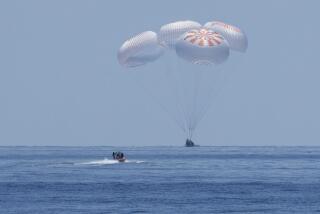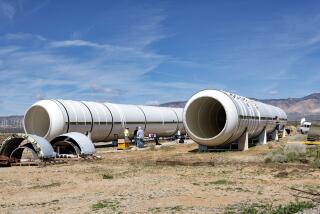Soviet Scientists Arriving Friday to Tour SDI Lab
- Share via
WASHINGTON — A delegation of top Soviet scientists, led by the chief negotiator at the strategic arms reduction talks in Geneva, will arrive Friday in Orange County for a unprecedented tour of a sensitive “Star Wars” research facility near San Clemente.
The Soviets’ two-day visit to Southern California will be shrouded in secrecy. Except for a brief picture-taking session when the 10-member delegation touches down at the U.S. Marine Corps Air Station at El Toro, neither the press nor the public has been invited to take part.
“This is essentially an extension of the (Geneva) talks,” a senior Bush Administration official said Wednesday. “Those talks are confidential between the two governments.”
Three senior U.S. officials discussed the weeklong Soviet visit to the United States at a briefing Wednesday, but they spoke on the condition that they not be named.
The Soviets will tour TRW Inc.’s Strategic Defense Initiative research facility Saturday. They will also spend two days early next week at the Los Alamos National Laboratory in New Mexico, where other SDI research is in progress.
The SDI program, also known as “Star Wars,” would create a partial shield against incoming nuclear ballistic missiles in part by stationing powerful lasers and other high-tech weaponry on rockets and satellites. The Soviet Union in recent years has been conducting similar research.
At the TRW Capistrano Test Site, situated on 2,000 acres of unincorporated land near San Clemente, the Soviet scientists will inspect a powerful chemical laser known as the Alpha Laser.
The laser, now in the early stages of development, could eventually be enlarged and installed on a space-based platform to test its ability to detect and destroy incoming ballistic missiles armed with nuclear warheads. Such tests are planned for the middle to late 1990s, according to the Strategic Defense Initiative Organization, the Defense Department unit that oversees the project.
At the Los Alamos laboratory, the Soviet delegation will examine a project to develop rocket-mounted devices that would generate powerful beams of atomic particles intended to either identify or destroy incoming missiles. This project is known as BEAR, or Beam Experiment Aboard Rocket.
Neither project is classified, but this is the first time that Soviet scientists will be permitted to inspect SDI laboratories where American scientists are working and the hardware they are working on, officials said.
The Soviet visit is scheduled to begin less than two weeks after the United States laid on the table in Geneva a proposal for a new Defense in Space Treaty. The treaty proposal is an attempt to set ground rules for the development of space-based defense systems.
One of the goals of the treaty is to avoid situations in which one side might surprise the other with new technological developments, creating a potentially dangerous shift in the balance of power. “The last thing you want is surprise,” one official said.
A key element of the U.S. proposal is reciprocal laboratory visits, along with mutual observation of tests, annual data exchanges and joint briefings, he said.
The tour of the two SDI research units, another official said, is intended to demonstrate to the Soviets how reciprocal visits might work. “We are trying to demonstrate a predictability measure,” he added.
“We believe that visits to laboratories are essential if the sides are to gain an early and wide window into each other’s research activities,” the official said. “We hope the visit will convince the Soviets of the value of regular and reciprocal laboratory visits.”
The Soviet official who will lead eight scientists and a Soviet Foreign Ministry official on the two SDI tours is Ambassador Yuri Nazarkin, head of the Soviet delegation to strategic arms and space defense talks in Geneva. The negotiations include both weapons in space and the strategic arms reduction talks. The Soviets will arrive in Washington today. The invitation was extended last September by Secretary of State James A. Baker III during a meeting with Soviet Foreign Minister Eduard A. Shevardnadze in Jackson Hole, Wyo. The Soviets so far have not invited American scientists to visit any of their space defense research facilities.
As originally proposed by President Reagan in 1983, SDI was to protect the nation with an impenetrable shield of space-based defenses.
In recent months, however, members of the Bush Administration have significantly lowered the official expectations for the program. Officials now say only that SDI would offer partial protection against incoming missiles.
The SDI budget has also faced cuts in Congress. The budget for the program this year is $3.8 billion, down from $4.1 billion last year.
More to Read
Sign up for Essential California
The most important California stories and recommendations in your inbox every morning.
You may occasionally receive promotional content from the Los Angeles Times.










